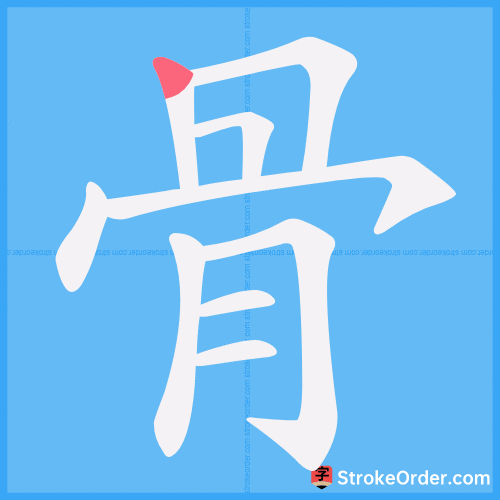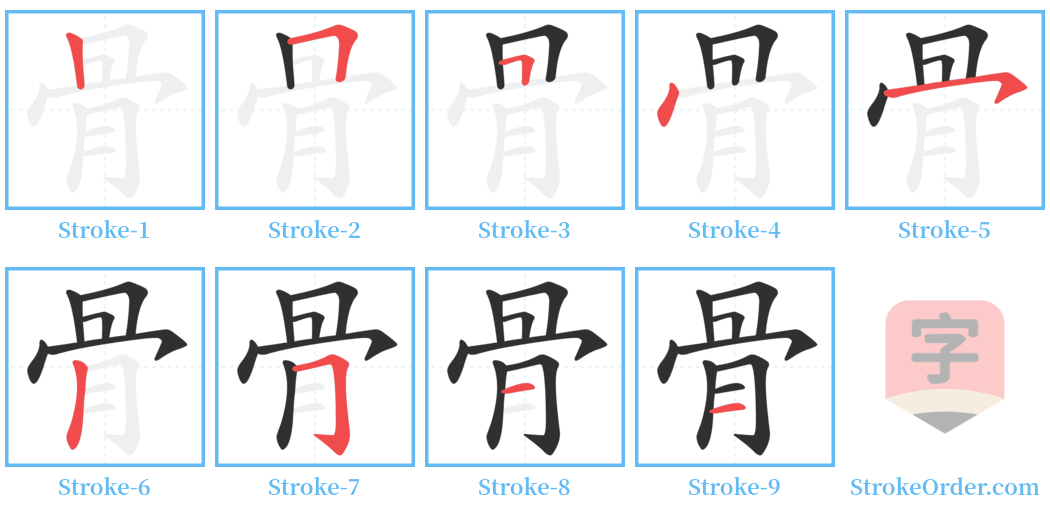骨 Stroke Order
Animated Stroke Order of 骨

Stroke Order Diagrams for 骨

Step-by-Step Handwriting Guide for 骨

Learn to Write Chinese Characters with Video Tutorials
Watch the video of writing the Chinese character "骨", learn the correct stroke order (笔顺) of the character "骨", and master the standard way of writing the character "骨".
Free Printable Handwriting Practice with Stroke Order: 骨
Printable Writing Practice Worksheet of "骨" in Portrait Orientation (Tian Zi Ge)

Printable Writing Practice Worksheet of "骨" in Landscape Orientation (Tian Zi Ge)

Information of 骨
Pinyin
gǔ、 gū
Radical
骨
Strokes
9 strokes
Usage
★★★★★
Definition
bone
骨 (gǔ)
[ Noun ]
【Basic meaning】: bone
1. Hard tissue inside the body of humans and vertebrates that supports the body and protects the internal organs.
- Example: 骨头 (bone), 骼 (totality of all bones in the body), 骨节 (bone joint), 骨肉 (1. refers to close relatives; also called "bone blood"; 2. metaphor for a closely connected and inseparable relationship), 骨干 (backbone).
2. Something resembling bone (referring to the framework that supports objects).
- Example: 伞骨 (umbrella frame), 扇骨 (fan frame).
3. Refers to the theory and pen strength of literary works.
- Example: 骨力 (1. vigorous pen strength; 2. resolute and unyielding spirit), 风骨 (a classical literary term referring to the artistic style of a piece as well as its underlying spirit).
4. Refers to a person's quality or spirit.
- Example: 侠骨 (heroic spirit), 骨气 (integrity).
5. Dead body or corpse (referring to a deceased person).
- Example: 骨殖 (corpse), 骨朽 (decomposed body).
6. The trunk of a person's body.
- Example: 骨相 (from a person's skeleton and appearance, one can predict wealth and fortune).
7. Metaphor for the frame or forcefulness of writing.
- Example: 骨格 (the form and style of poetry and prose).
8. Metaphor for resolute and upright character.
- Example: 骨直 (the uprightness of a person).
9. Metaphor for a vigorous style of writing.
- Example: 骨力 (vigor of writing).
10. See also gū.
【引】(References)
1. 《说文》: Bone, the essence of flesh.
2. 《素问·脉要精微论》: Bone is the abode of marrow.
3. 《管子·四时》: Wind arises from wood and bone.
4. 《战国策·燕策》: The horse has died, selling its bones for five hundred gold.
5. 《韩非子·安危》: To stab the bone with a knife.
6. 清· 方苞《左忠毅公逸事》: His forehead was burnt and unrecognizable, and the muscles and bones below the left knee had completely detached.
This entry covers various meanings and usages of the character "骨," highlighting its literal anatomical significance as well as its metaphorical applications in literature and character description.
tortoise shell and animal bones used in divination / oracle bone inscriptions (an early form of Chinese script)
Input Method for 骨
Pinyin
gu3
Wubi
mef
Cangjie
bbb
Zhengma
lw
Four Corner
77227
Unicode
U+9aa8
Same Pronunciation Characters